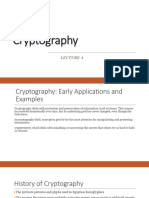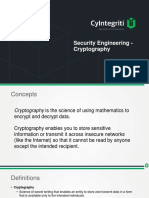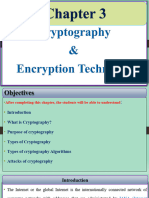0% found this document useful (0 votes)
64 views23 pagesCryptography Introduction
This document provides an introduction to the HTCS6702 - Cryptography course. It discusses the goals of understanding real-world cryptography through a rigorous approach. It also outlines some of the key topics that will be covered, including private-key encryption, public-key encryption, digital signatures, and cryptographic building blocks. The document provides a brief history of cryptography, noting how it has evolved from a historical focus on secrecy to a more scientific approach today.
Uploaded by
M NCopyright
© © All Rights Reserved
We take content rights seriously. If you suspect this is your content, claim it here.
Available Formats
Download as PDF, TXT or read online on Scribd
0% found this document useful (0 votes)
64 views23 pagesCryptography Introduction
This document provides an introduction to the HTCS6702 - Cryptography course. It discusses the goals of understanding real-world cryptography through a rigorous approach. It also outlines some of the key topics that will be covered, including private-key encryption, public-key encryption, digital signatures, and cryptographic building blocks. The document provides a brief history of cryptography, noting how it has evolved from a historical focus on secrecy to a more scientific approach today.
Uploaded by
M NCopyright
© © All Rights Reserved
We take content rights seriously. If you suspect this is your content, claim it here.
Available Formats
Download as PDF, TXT or read online on Scribd
/ 23
























































